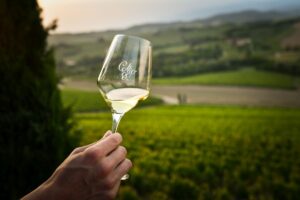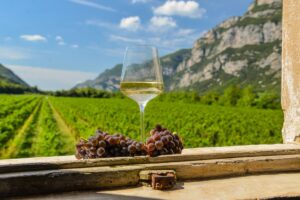The quality of a vintage is always a highly discussed topic, especially in this period, in the form of predictions, which is the least reliable but at the same time the most debated one. This year it is even more pertinent as it is definitely an unpredictable year…but maybe not. This year’s harvest started early in many areas and has been called a great harvest. This is obviously a premature judgment and in any event, not supported by facts that will instead form the definitive judgment on this vintage.
It all actually depends on what one intends for the adjective “great”. At the moment, the grapes are healthy, favored by the heat, which is not necessarily a sufficient premise for a great vintage. It is a hot vintage, aggravated by a long drought due to a shortage of winter and springtime rainfalls that will certainly have positive aspects (for instance, few treatments for vine diseases, or abundance of sugars).
Will these parameters be sufficient to produce quality wines, and make it a great vintage? In the case of healthy grapes, we agree that the less grapes are "treated" the better they are; that is, healthier (but only healthier), and, if they also have a high sugar content, they will give better wines.
Viticulture is an uncertain agricultural practice because it depends on meteorological whims, and nowadays, more and more on climatic ones. Atmospheric conditions can give an extraordinary vintage or destroy the whole harvest.
Of course, between these extreme situations, there are a number of "intermediate" vintages, which case by case are classified as more or less good or more or less bad. The question of when to judge a vintage, fortunately or not, are those precise moments not represented by the various physiological stages of grape ripening (sprouting, flowering, allegation, which however determine early or late harvest). Early judgments can be pronounced only after bringing the grapes to the cellar. In general, the three weeks prior to harvest time are crucial and can decimate the size of a vintage. Moreover, it is necessary to wait for the fermentation to know whether all the premises (good or bad) will be maintained (or can be corrected) in the wine. In addition, a great wine needs time; you have to wait patiently to fully understand its evolution.
Further, one must add the obvious and key differences of the various territories as well as the different wine areas.
Balance is the goal in order to achieve a great wine. Unfortunately, this element, besides being linked to the human being's know how (and not secondarily the technology available in the cellar), depends largely on the vine-soil-climate interactions.
There are not thousands of places in Italy or the rest of the world that are dedicated to the production of great wines. The combination of chemical characteristics of the soil is rare, and we know how much it influences the sensory qualities of a wine; the climate, capable of temporarily or structurally influencing the quality of a product; exposure of the vineyards and their age (the older they are the more they are able to resist climatic stress and produce more balanced grapes).
When is the grape really ripe? The ripeness of the grape is given by the sugar / acid ratio in the pulp. A grape berry is physiologically ripe when the seed is ripe and is able to germinate. Grape seeds, from a physiological point of view, ripen during rotation, but considering the technological ripening of the fruit, berries and grape seeds are switched (that is, when they are ripe for the plant, they are not ripe for us). From a physiological point of view, technological maturity is the aging of the grape in which an alteration of the fruit facilitates the extraction of the skin and the pulp, where various substances accumulate and which are fundamental to the quality of a wine.
It is obviously a rather complex picture that needs to be simplified, but often this leads to misunderstandings. In the end, so as not to make mistakes or do any damage, one gives the title of great vintage to all or almost all vintages. The result, though, is a trend that standardizes the consistency of the various vintages and no longer sees diversity, for good or for bad, which is such an important aspect of the magic of wine.
Looking at the last 10 vintages (2007-2017), there were only two very good vintages: 2010 and 2015 (for different reasons, though). The remaining vintages can be categorized as discreet, perhaps putting 2013 a step up, and 2014, instead was probably the worst (but the magic of unpredictability made 2014 a great vintage in Sicily). There wasn’t then, a really great vintage in that period. This judgment, though questionable, is based on the period we indicate as necessary to understand the quality of a vintage.
And what can we conclude from the climatic analysis of a decade of harvests? Clearly, the hot years win over the cool ones: 6 to 4 (2007, 2008, 2009, 2011, 2012, 2015, 2017 the hot years and 2010, 2013, 2014, 2016 cool years).
2007 was one of the hottest (and early) in recent years. April was dry and May followed with some rainfall. From June to September the weather was sunny with very high temperatures (and some high peaks) and the temperature did fall below 25 degrees even in September. October was dry and mild. Early varieties suffered the most, while the late varieties in general yielded good results, and some excellent ones.
In 2008, weather conditions in September and October extended the harvest period allowing for high quality in Central - Northern Italy. It will be remembered as a mixed vintage; good, with some excellent peaks.
2009 was a hot and bizarre year, with above average temperatures. Central and Northern Italy did better, while in the South, the bizarre climate and weather conditions, characterized by high temperatures, then long periods of rain, made it variable, resulting in spotted quality where mediocre clashed with very good and good with discreet.
2010 was a very good year with lots of rain in the spring, a long, cool summer and an ideal harvest period, dry and perfect temperatures. The harvest started out rainy but from the third decade on it was almost always beautiful weather for the entire harvest.
In 2011, the last two weeks of August and September slashed all records for heat, and they left their mark, making it a difficult year. The weather was cool and fairly regular until August when temperatures climbed and stayed around 35 degrees, and together with hot and dry winds, overheated the grapes. Therefore, the harvest started very early, to avoid grapes becoming over ripe.
Even in 2012, the weather was variable, with a tendency to a very warm climate. In the first part of spring, temperatures were already above average. The month of April instead, was mostly bad weather and abundant rainfall that however gave a water reserve to compensate for a very hot summer, marking temperatures up to 40 degrees, almost constantly.
In 2013, the climate swung back and forth. It was less dry than previous years, day and night temperatures were balanced and favored gradual ripening, excellent for Italian vines. The summer was cool and rainy for a short break between August and September, which allowed the grapes to continue ripening (though not completely).
2014 was perhaps the most complicated year. Spring was cold while summer was rainy causing a real season upheaval of the usual Mediterranean climate dynamics. The rains were heavy and sometimes in the form of water bombs; it hailed just a few days before harvest and there were whirlwinds and big temperature swings. The heavy rainfall in August had a major impact in the northern regions, while in the South there were a few exceptional results.
In 2015 the seasons were regular. Winter was quite cold, followed by a pleasant spring and a hot summer, with a few drizzles at the end of July. There was enough rainfall to fill the water reserve for the hotter months. Grapes reached perfect ripeness with a perfect balance of sugar and acidity. 2016 marked the return to meteorological instability, where rainfall and the humidity rates were generally high, causing an increase mainly in vine diseases (powdery mildew, rot and downy mildew).
Rainfall was abundant from April to June, and above average in all the regions. Summer was not particularly hot, and weather conditions were stable at the crucial times. Wines are still in the making, but basically there will be no exceptional quality peaks.
In this perspective, then, 2017 obviously belongs to the hot vintages, and has many characteristics common to years 2007, 2009, 2011, 2012 and 2015.
It is very early, just like 2007, but is also similar to 2003, though night temperatures were not at all the same 14 years ago , and dry like 2012, while heat waves are comparable to 2011 and 2015. These are the references, or at least those closest to us time wise, needed to understand what kind of vintage we can expect, beyond judgments and predictions.
Copyright © 2000/2025
Contatti: info@winenews.it
Seguici anche su Twitter: @WineNewsIt
Seguici anche su Facebook: @winenewsit
Questo articolo è tratto dall'archivio di WineNews - Tutti i diritti riservati - Copyright © 2000/2025







































































































































































































